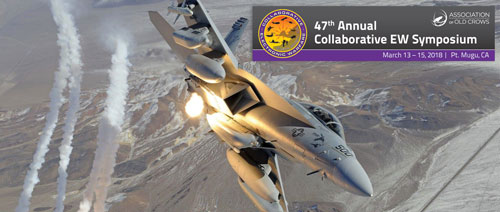Print this Article | Send to Colleague

CALL FOR PRESENTATIONS: 47th Annual Collaborative EW Symposium, March 13-15, Pt. Mugu, CA
As EW warfighting requirements continue to evolve in their complexity and interdependency, it is clear that future EW systems must work collaboratively with other Air, Ground, Surface Space and Cyberspace systems. The 47th Annual Point Mugu Electronic Warfare Symposium will facilitate the exchange of enabling concepts and provide a venue to disseminate current research in the fields of Collaborative Electronic Warfare. Prominent leaders, contributors and representatives from the United States military, government, academia, and industry will come together to address current Electronic Warfare gaps and emerging technologies in Collaborative Electronic Warfare required to address these gaps.
CALL FOR PRESENTATIONS
This call for presentations challenges presenters to explore enabling collaborative electronic warfare through innovation and invention. We will accept presentations and/or demonstrations from all United States services, Department of Defense, industry, and academia that identify technical paths, options, and potential opportunities for EW collaboration. Specifically, abstracts should address one or more of the symposium sessions:
1. Planning/Directing/Assessing Collaborative EW. Collaborative EW is driving mission planning to a new reality. To achieve efficient coordination with and tasking of distributed and cognitive networked EW systems, mission planning needs to be capable of working with multiple disparate systems before, during, and after a mission. The challenges of enabling dynamic resource allocation by EW operators working with unmanned and cognitive systems at the tactical to operational levels need to be addressed.
2. Testing and Demonstration of Cognitive and Collaborative Systems. Improvements in the testing, modeling, and demonstration of collaborative EW systems against modern/next gen threats is essential to gaining and maintaining advantage in EW. Advancements in the Live Virtual Constructive infrastructure as well as collaboration with the gaming and other related commercial industries are examples of areas to be explored.
3. Autonomy vs. Control of Cognitive EW Systems. The optimal employment of cognitive and autonomous EW systems is a challenge for the designers and developers as well as the operators. The level of interaction required/desired between the operators and the cognitive EW systems in their span of control are functions of many factors including trust, reliability, speed, and awareness of changes by the cognitive systems.
Abstracts for presentations must be unclassified and no more than one page of text or 400 words. Please forward abstracts to Amy Belicev at belicev@crows.org by February 3, 2018. All sessions will be classified SECRET NOFORN.

